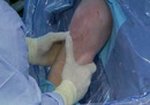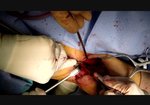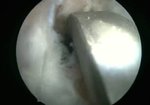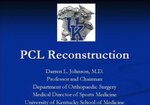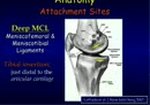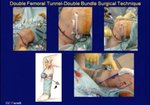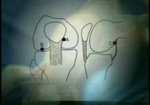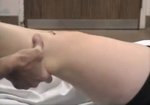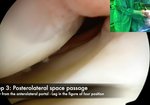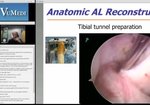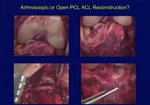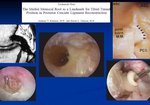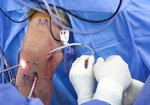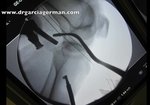Playback speed
10 seconds
Arthroscopic PCL Inlay Reconstruction with Achilles Tendon Allograft
By
NYU Langone Orthopedics
FEATURING
Robert Daher
By
NYU Langone Orthopedics
FEATURING
Robert Daher
5,332 views
August 6, 2012
Summary
This video demonstrates an arthroscopic PCL inlay reconstruction using achilles tendon allograft.
Introduction
Many ...
read more ↘ techniques exist for arthroscopic PCL reconstruction, and the optimal technique remains controversial. Choices of grafts include bone patella bone and achilles tendon allografts. Studies (ie Fanelli et al.. 1996) have shown no disadvantage to using either one. The two most popular techniques are transtibial and inlay techniques, with both reporting satisfactory outcomes. A recent review by May et al. in 2010 concluded that both are reasonable and comparable options. However, prospective clinical trials are still needed.
Materials & Methods
The construct used included an achilles tendon allograft, small bone graft, two buttons and a TightRope (Arthrex, Inc, Naples, FL) system. The achilles tendon allograft was secured to the bone graft using the first button, which would ultimately be positioned over the midline posterior entrance of the tibial tunnel created for the procedure. The TightRope construct was fastened to both the second button (on the anteriomedial tibial tunnel entrance) and the first button/Achilles tendon graft/bone graft amalgamation. The TightRope is passed through the tibial tunnel in a posterior to anterior direction, after which the achilles tendon allograft and bone graft are engaged on the posterior tibial tunnel entrance. The second button secures the TightRope on the anterior tibia. The achilles tendon graft is then passed through the femoral tunnel and fixed using an interference screw.
Results
The literature has so far reported good clinical results using this technique due to the superior biomechanics of the open tibial inlay, the ease of arthroscopic visualization and the decreased morbidity associated with it. We report a case of a successful clinical outcome after arthroscopic PCL inlay reconstruction with achilles tendon allograft.
Discussion
Our demonstrated technique is an effective method for PCL reconstruction. Additionally, it reduces the “Killer Turn” angle associated with other arthroscopic PCL reconstruction techniques.
↖ read less
This video demonstrates an arthroscopic PCL inlay reconstruction using achilles tendon allograft.
Introduction
Many ...
read more ↘ techniques exist for arthroscopic PCL reconstruction, and the optimal technique remains controversial. Choices of grafts include bone patella bone and achilles tendon allografts. Studies (ie Fanelli et al.. 1996) have shown no disadvantage to using either one. The two most popular techniques are transtibial and inlay techniques, with both reporting satisfactory outcomes. A recent review by May et al. in 2010 concluded that both are reasonable and comparable options. However, prospective clinical trials are still needed.
Materials & Methods
The construct used included an achilles tendon allograft, small bone graft, two buttons and a TightRope (Arthrex, Inc, Naples, FL) system. The achilles tendon allograft was secured to the bone graft using the first button, which would ultimately be positioned over the midline posterior entrance of the tibial tunnel created for the procedure. The TightRope construct was fastened to both the second button (on the anteriomedial tibial tunnel entrance) and the first button/Achilles tendon graft/bone graft amalgamation. The TightRope is passed through the tibial tunnel in a posterior to anterior direction, after which the achilles tendon allograft and bone graft are engaged on the posterior tibial tunnel entrance. The second button secures the TightRope on the anterior tibia. The achilles tendon graft is then passed through the femoral tunnel and fixed using an interference screw.
Results
The literature has so far reported good clinical results using this technique due to the superior biomechanics of the open tibial inlay, the ease of arthroscopic visualization and the decreased morbidity associated with it. We report a case of a successful clinical outcome after arthroscopic PCL inlay reconstruction with achilles tendon allograft.
Discussion
Our demonstrated technique is an effective method for PCL reconstruction. Additionally, it reduces the “Killer Turn” angle associated with other arthroscopic PCL reconstruction techniques.
↖ read less
Comments 7
Login to view comments.
Click here to Login


